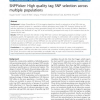1215 search results - page 242 / 243 » Introduction to genetic programming |
TMC
2010
13 years 3 months ago
2010
—This paper presents SYNAPSE++, a system for over the air reprogramming of wireless sensor networks (WSNs). In contrast to previous solutions, which implement plain negative ackn...
BMCBI
2011
12 years 11 months ago
2011
Background: Linkage Disequilibrium (LD) bin-tagging algorithms identify a reduced set of tag SNPs that can capture the genetic variation in a population without genotyping every s...
BMCBI
2011
12 years 8 months ago
2011
Background: Using microarray and sequencing platforms, a large number of copy number variations (CNVs) have been identified in humans. In practice, because our human genome is a d...
BMCBI
2010
13 years 5 months ago
2010
Background: The pan-genome of a bacterial species consists of a core and an accessory gene pool. The accessory genome is thought to be an important source of genetic variability i...
BMCBI
2006
13 years 5 months ago
2006
Background: Single nucleotide polymorphisms (SNP) constitute more than 90% of the genetic variation, and hence can account for most trait differences among individuals in a given ...

